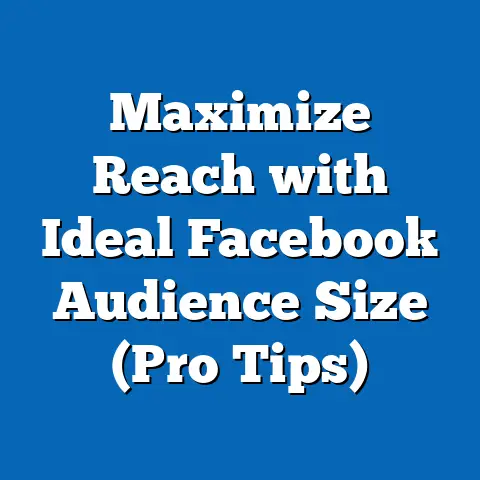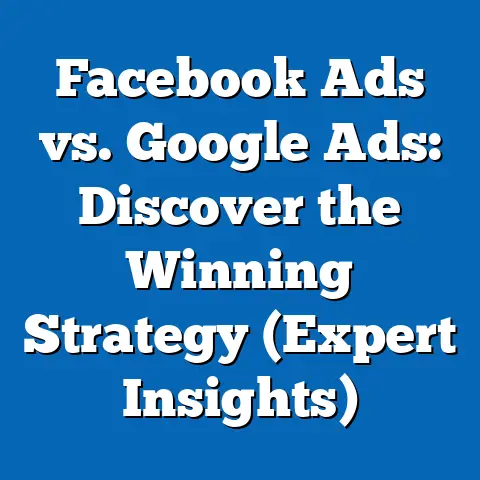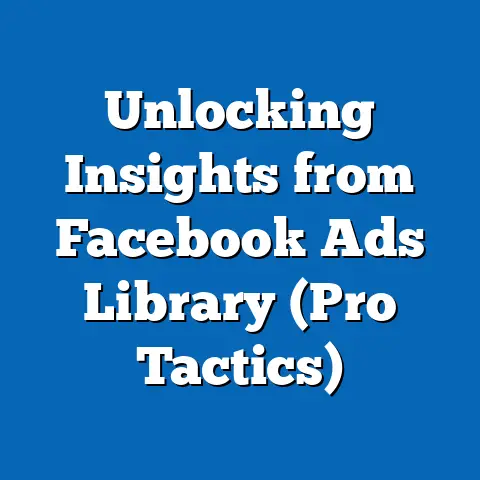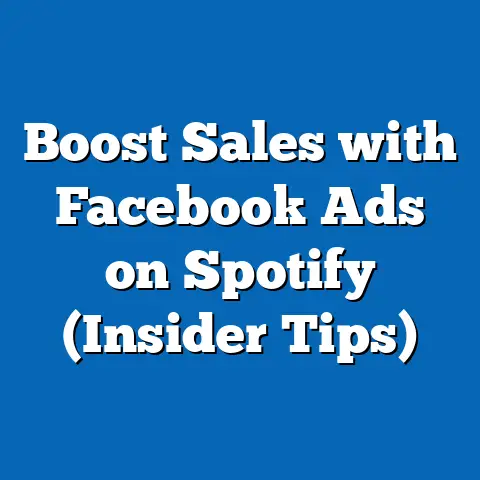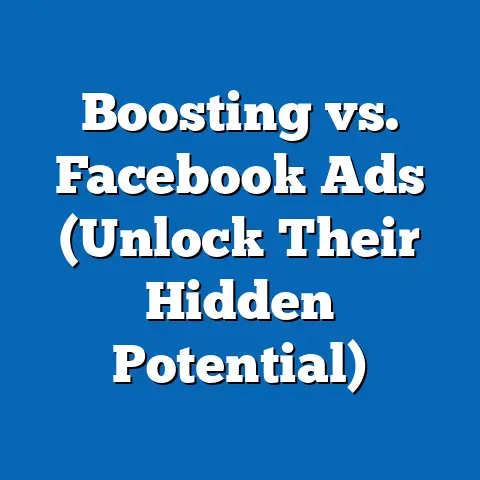Boost Facebook Lead Ads Landing Page (Proven Strategies)
Have you ever felt like you’re throwing money into a black hole with your Facebook Lead Ads? You meticulously craft your ad, target the perfect audience, and then… crickets. Low conversion rates can be frustrating, especially when you know Facebook Ads have the potential to be a lead-generating powerhouse. The truth is, a killer ad is only half the battle. The unsung hero of successful Facebook Lead Ads is often the landing page that follows.
I’ve seen countless businesses, including my own ventures, struggle with this. They focus so much on the ad itself that they neglect the crucial step of optimizing the landing page. Think of it like this: you’ve invited someone to your house, but when they arrive, the front door is broken, the lawn is overgrown, and the whole place looks uninviting. They’re likely to turn around and leave.
Section 1: Understanding Facebook Lead Ads
Facebook Lead Ads are a powerful tool within the Facebook advertising ecosystem designed specifically for lead generation. They offer a seamless experience for users, allowing them to submit their information directly within the Facebook platform, without having to navigate to an external website. This ease of use often translates to higher conversion rates compared to traditional ads that require users to click through to a website.
Defining Facebook Lead Ads and Their Purpose
Essentially, Facebook Lead Ads are a type of ad format that allows you to collect information from potential customers directly on Facebook and Instagram. Instead of driving traffic to your website, the lead form pops up directly within the user’s Facebook experience. This eliminates friction, making it incredibly easy for people to express interest in your product or service.
The primary purpose of Facebook Lead Ads is to generate high-quality leads for your business. These leads can then be nurtured and converted into paying customers. This ad format is particularly effective for:
- Building email lists: Offer a valuable freebie, like an e-book or webinar, in exchange for email addresses.
- Generating sales leads: Collect contact information from potential customers interested in your products or services.
- Gathering customer feedback: Use lead forms to conduct surveys and gather valuable insights.
- Promoting events: Collect registrations for webinars, workshops, or conferences.
How Lead Ads Differ from Traditional Ads
The key difference between Facebook Lead Ads and traditional ads lies in the user experience. Traditional ads typically drive traffic to an external website, where users are then asked to fill out a form. This extra step can lead to drop-off, as users may be hesitant to leave the Facebook platform or may find the website cumbersome to navigate on mobile.
Lead Ads, on the other hand, keep users within the Facebook environment. The lead form is pre-populated with information already available on the user’s Facebook profile, such as their name, email address, and phone number. This makes it incredibly quick and easy for users to submit their information, leading to higher conversion rates.
Here’s a breakdown of the key differences:
| Feature | Facebook Lead Ads | Traditional Ads |
|---|---|---|
| User Experience | Seamless, in-platform form submission | Requires navigating to an external website |
| Form Pre-fill | Fields often pre-populated with user data | User must manually fill out all fields |
| Conversion Rates | Generally higher due to reduced friction | Can be lower due to extra steps and website load |
| Mobile-Friendly | Optimized for mobile devices within the platform | Website may not be fully optimized for mobile |
| Feature | Facebook Lead Ads | Traditional Ads |
|---|---|---|
| User Experience | Seamless, in-platform form submission | Requires navigating to an external website |
| Form Pre-fill | Fields often pre-populated with user data | User must manually fill out all fields |
| Conversion Rates | Generally higher due to reduced friction | Can be lower due to extra steps and website load |
| Mobile-Friendly | Optimized for mobile devices within the platform | Website may not be fully optimized for mobile |
Anatomy of a Facebook Lead Ad
To effectively leverage Facebook Lead Ads, it’s crucial to understand their key components:
- Ad Creative (Image or Video): This is the visual element that captures the user’s attention and communicates your offer. High-quality images or videos are essential for attracting clicks.
- Headline: A concise and compelling headline that grabs the user’s attention and clearly communicates the benefit of submitting the form.
- Text (Ad Copy): A brief description that provides more information about your offer and encourages users to fill out the form.
- Call-to-Action (CTA) Button: A prominent button that prompts users to take action, such as “Sign Up,” “Download,” or “Get Quote.”
- Lead Form: The form that users fill out to submit their information. This is where you collect the data you need to generate leads.
- Privacy Policy Link: A link to your privacy policy, which is required by Facebook.
- Thank You Page: A page that users see after submitting the form. This is an opportunity to thank them for their interest and provide further instructions.
Mobile Optimization is Key:
Given that the majority of Facebook users access the platform on mobile devices, it’s absolutely critical to ensure that your Lead Ads are optimized for mobile. This means using high-quality images or videos that look great on smaller screens, writing concise and compelling copy, and designing a lead form that is easy to fill out on a mobile device.
Takeaway: Facebook Lead Ads are a powerful lead generation tool that offers a seamless user experience and often results in higher conversion rates compared to traditional ads. Understanding the anatomy of a Lead Ad and optimizing for mobile are crucial for success.
Section 2: The Importance of a Landing Page
While Facebook Lead Ads excel at capturing initial interest and collecting basic information, the real magic happens when you connect those leads to a dedicated landing page. This is where you can provide more in-depth information, build trust, and ultimately guide potential customers further down the sales funnel.
The Role of a Landing Page in the Context of Lead Ads
Think of the Lead Ad as the initial handshake and the landing page as the opportunity for a more meaningful conversation. The Lead Ad piqued their interest, but the landing page is where you solidify that interest and demonstrate the true value of your offer.
Here’s why a landing page is so important:
- Provides More Information: Lead Ads have limited space for text and visuals. A landing page allows you to provide a more detailed explanation of your product, service, or offer.
- Builds Trust and Credibility: A well-designed landing page with testimonials, case studies, and guarantees can help build trust and credibility with potential customers.
- Qualifies Leads: By asking more specific questions on the landing page, you can qualify leads and identify those who are most likely to convert into paying customers.
- Nurtures Leads: The landing page can serve as a starting point for lead nurturing. You can provide valuable content, such as blog posts, e-books, or webinars, to keep leads engaged and move them further down the sales funnel.
- Tracks Conversions: A dedicated landing page makes it easier to track conversions and measure the effectiveness of your Lead Ads campaign.
Common Pitfalls of Using Generic Landing Pages
Many businesses make the mistake of directing leads from their Facebook Ads to a generic homepage or a poorly designed landing page. This can be a major conversion killer.
Here are some common pitfalls to avoid:
- Lack of Relevance: The landing page should be directly relevant to the offer in the Lead Ad. If the ad promises a free e-book on “Facebook Advertising for Beginners,” the landing page should immediately deliver on that promise.
- Poor Design: A cluttered, confusing, or outdated landing page can damage your credibility and turn off potential customers.
- Slow Loading Speed: In today’s fast-paced world, users expect websites to load quickly. A slow-loading landing page can lead to high bounce rates.
- Lack of Mobile Optimization: As mentioned earlier, the majority of Facebook users are on mobile. A landing page that is not optimized for mobile will provide a poor user experience.
- Missing Call-to-Action: The landing page should have a clear and compelling call-to-action that tells users what you want them to do next, whether it’s downloading a free resource, requesting a demo, or contacting sales.
The Impact of a Well-Optimized Landing Page
A well-optimized landing page can have a dramatic impact on your lead generation efforts. Studies have shown that businesses with optimized landing pages experience significantly higher conversion rates compared to those that use generic landing pages.
Real-World Example:
I worked with a local real estate agency that was struggling to generate leads through Facebook Ads. Their ads were driving traffic to their homepage, which was cluttered and confusing. After redesigning their landing page to be more focused and user-friendly, and directly relevant to the ad offer (a free guide to buying your first home), they saw a 250% increase in lead generation within the first month. This dramatic improvement highlights the power of a well-optimized landing page.
Statistics to Consider:
- Businesses with 40+ landing pages generate 12 times more leads than those with 5 or fewer. (HubSpot)
- The average landing page conversion rate across industries is 2.35%. However, the top 25% are converting at 5.31% or higher. (WordStream)
- A/B testing can improve lead generation by up to 40%. (HubSpot)
Takeaway: A dedicated, well-optimized landing page is crucial for maximizing the effectiveness of your Facebook Lead Ads. Avoid common pitfalls like lack of relevance, poor design, and slow loading speed. By focusing on providing a clear, compelling, and user-friendly experience, you can significantly boost your lead generation efforts.
Section 3: Proven Strategies to Optimize Your Facebook Lead Ads Landing Page
Now that we’ve established the importance of a landing page, let’s dive into specific strategies you can use to optimize your landing page for higher conversion rates.
3.1 Crafting Compelling Headlines
Your headline is the first thing visitors see when they land on your page. It’s your chance to grab their attention and convince them to stay. A compelling headline should be:
- Clear and Concise: Avoid jargon and ambiguity. Make sure visitors understand what your offer is within seconds.
- Benefit-Driven: Focus on the value visitors will receive. What problem will you solve for them?
- Urgent (Optional): Creating a sense of urgency can encourage immediate action.
- Specific: Use numbers and data to make your headline more believable.
Examples of Effective Headlines:
- Weak: “Learn More About Our Services”
-
Strong: “Double Your Website Traffic in 30 Days: Free Guide Reveals Our Proven Strategies”
-
Weak: “Download Our Free E-book”
-
Strong: “The Ultimate Guide to Facebook Advertising in 2024: Download Your Free Copy Now!”
-
Weak: “Get a Free Consultation”
- Strong: “Free 30-Minute Marketing Consultation: Discover How to Increase Your Leads by 50%”
Strong: “Double Your Website Traffic in 30 Days: Free Guide Reveals Our Proven Strategies”
Weak: “Download Our Free E-book”
Strong: “The Ultimate Guide to Facebook Advertising in 2024: Download Your Free Copy Now!”
Weak: “Get a Free Consultation”
Analyzing What Makes Them Work:
The “strong” headlines are more effective because they are specific, benefit-driven, and in some cases, create a sense of urgency. They clearly communicate the value proposition and entice visitors to learn more.
Actionable Tip: Brainstorm at least 10 different headlines for your landing page before settling on the best one. Test different variations using A/B testing (more on that later) to see which performs best.
3.2 Designing an Intuitive User Experience
User experience (UX) is paramount when it comes to landing page optimization. A well-designed landing page should be easy to navigate, visually appealing, and optimized for conversions.
Best Practices for Landing Page Design:
- Clean and Uncluttered Layout: Avoid overwhelming visitors with too much information. Use white space to create a visually appealing and easy-to-read layout.
- Clear Visual Hierarchy: Guide visitors’ eyes to the most important elements on the page, such as the headline, image, and call-to-action.
- Mobile-First Design: Ensure your landing page is fully responsive and looks great on all devices, especially mobile.
- Fast Loading Speed: Optimize images and code to ensure your landing page loads quickly.
- Consistent Branding: Maintain a consistent brand identity across your landing page and your Facebook Ads.
Examples of High-Converting Landing Pages:
- Dropbox: Their landing page is clean, simple, and clearly communicates the value proposition of their service.
- Unbounce: Unbounce’s own landing pages are excellent examples of best practices. They use strong headlines, compelling copy, and clear calls-to-action.
- Neil Patel: Neil Patel’s landing pages are known for their data-driven approach and persuasive copy.
Dissecting Their Design Elements:
These high-converting landing pages share several common design elements:
- Strong Visuals: High-quality images or videos that capture attention and communicate the value proposition.
- Clear Headlines and Subheadings: Easy-to-read headlines and subheadings that guide visitors through the page.
- Compelling Copy: Persuasive copy that highlights the benefits of the offer.
- Prominent Call-to-Action: A clear and compelling call-to-action that tells visitors what to do next.
- Social Proof: Testimonials, reviews, and case studies that build trust and credibility.
Actionable Tip: Analyze successful landing pages in your industry and identify the design elements that resonate with you. Use these elements as inspiration for your own landing page design.
3.3 Writing Persuasive Copy
Your landing page copy should be clear, concise, and persuasive. It should highlight the benefits of your offer and convince visitors to take action.
Tips for Writing Effective Copy:
- Focus on Benefits, Not Features: Explain how your product or service will solve their problems and improve their lives.
- Use Strong Verbs: Use action-oriented verbs that encourage visitors to take action.
- Keep it Concise: Avoid jargon and unnecessary words. Get straight to the point.
- Use Emotional Triggers: Appeal to visitors’ emotions by highlighting their hopes, fears, and desires.
- Tell a Story: Use storytelling to connect with visitors on a personal level and make your offer more relatable.
Formula for Creating Persuasive Content:
A simple formula for creating persuasive content is the AIDA formula:
- Attention: Grab the visitor’s attention with a compelling headline and visual.
- Interest: Generate interest by highlighting the benefits of your offer.
- Desire: Create desire by appealing to their emotions and showcasing the value of your offer.
- Action: Prompt them to take action with a clear and compelling call-to-action.
Example:
“Are you tired of struggling to generate leads on Facebook? Our free guide reveals the proven strategies we use to double our clients’ lead generation in just 30 days. Download your copy now and discover the secrets to Facebook advertising success!”
Actionable Tip: Write your landing page copy as if you’re speaking directly to your ideal customer. Address their pain points and explain how your offer can help them achieve their goals.
3.4 Leveraging Social Proof and Testimonials
Social proof is the psychological phenomenon where people are more likely to take action if they see that others have already done so. It’s a powerful way to build trust and credibility on your landing page.
Types of Social Proof:
- Testimonials: Quotes from satisfied customers that highlight the benefits of your product or service.
- Reviews: Ratings and reviews from third-party websites, such as Google Reviews or Yelp.
- Case Studies: Detailed stories that showcase how your product or service has helped other businesses achieve success.
- Social Media Mentions: Screenshots of positive comments or mentions on social media.
- Trust Badges: Logos of reputable organizations or certifications that demonstrate your credibility.
How to Effectively Use Social Proof:
- Use Real Names and Photos: Authentic testimonials with real names and photos are more believable.
- Highlight Specific Benefits: Focus on the specific benefits that customers have experienced.
- Use a Variety of Social Proof: Incorporate different types of social proof to appeal to a wider audience.
- Place Social Proof Strategically: Place testimonials and reviews near your call-to-action to encourage conversions.
Actionable Tip: Reach out to your satisfied customers and ask them for testimonials. Offer incentives, such as discounts or free products, in exchange for their feedback.
3.5 Utilizing Strong Calls-to-Action
Your call-to-action (CTA) is the most important element on your landing page. It’s the button or link that tells visitors what you want them to do next.
Characteristics of a Strong CTA:
- Clear and Concise: Use action-oriented verbs that clearly communicate what visitors will receive.
- Benefit-Driven: Highlight the benefits of taking action.
- Visually Prominent: Make your CTA button stand out with a contrasting color and a clear design.
- Urgent (Optional): Create a sense of urgency to encourage immediate action.
- Personalized (Optional): Personalize your CTA to make it more relevant to the visitor.
Examples of Strong CTAs:
- “Download Your Free E-book Now!”
- “Get Started Today!”
- “Claim Your Discount”
- “Request a Free Demo”
- “Learn More”
Analyzing What Makes Them Effective:
These CTAs are effective because they are clear, concise, and benefit-driven. They tell visitors exactly what they will receive by taking action.
Actionable Tip: Experiment with different CTA variations to see which performs best. Use A/B testing to test different colors, wording, and placement.
3.6 A/B Testing for Continuous Improvement
A/B testing (also known as split testing) is the process of comparing two versions of a landing page to see which performs better. It’s a crucial step in optimizing your landing page for higher conversion rates.
How to Conduct A/B Tests:
- Identify a Variable to Test: Choose one element on your landing page to test, such as the headline, image, copy, or call-to-action.
- Create Two Versions: Create two versions of your landing page, with one version (the control) containing the original element and the other version (the variation) containing the changed element.
- Split Your Traffic: Divide your traffic evenly between the two versions of your landing page.
- Track Your Results: Use analytics tools, such as Google Analytics or Facebook Pixel, to track the performance of each version.
- Analyze Your Results: After a sufficient amount of traffic has been sent to each version, analyze the results to see which version performed better.
- Implement the Winning Version: Implement the winning version of your landing page and start the testing process again with a different variable.
What to Test:
- Headlines: Test different headlines to see which captures the most attention.
- Images: Test different images to see which resonates best with your audience.
- Copy: Test different copy variations to see which is more persuasive.
- Call-to-Action: Test different CTA wording, colors, and placement.
- Layout: Test different layouts to see which is most user-friendly.
Actionable Tip: Use A/B testing tools, such as Google Optimize or Optimizely, to simplify the testing process.
Takeaway: Optimizing your Facebook Lead Ads landing page is an ongoing process. By implementing these proven strategies and continuously testing and refining your approach, you can significantly boost your lead generation efforts.
Section 4: Tracking and Measuring Success
Optimizing your landing page isn’t a one-time task. It’s an iterative process that requires constant monitoring and analysis. Tracking the right metrics allows you to understand what’s working, what’s not, and where you can make improvements.
Key Performance Indicators (KPIs) to Monitor
Here are some key performance indicators (KPIs) you should be tracking to measure the effectiveness of your Facebook Lead Ads and landing pages:
- Click-Through Rate (CTR): The percentage of people who see your ad and click on it. A higher CTR indicates that your ad is relevant and engaging.
- Landing Page Conversion Rate: The percentage of people who visit your landing page and complete the desired action, such as filling out a form or downloading a free resource. A higher conversion rate indicates that your landing page is effective at persuading visitors to take action.
- Cost Per Lead (CPL): The average cost of acquiring a lead through your Facebook Lead Ads campaign. A lower CPL indicates that your campaign is efficient.
- Lead Quality: Not all leads are created equal. It’s important to track the quality of your leads to ensure that they are likely to convert into paying customers. This can be done by monitoring metrics such as lead source, lead score, and sales conversion rate.
- Bounce Rate: The percentage of people who visit your landing page and leave without interacting with it. A high bounce rate indicates that your landing page is not engaging or relevant.
- Time on Page: The average amount of time that visitors spend on your landing page. A longer time on page indicates that your landing page is engaging and informative.
Using Facebook Insights and Google Analytics
Facebook Insights and Google Analytics are two powerful tools that can provide valuable data about the performance of your Facebook Lead Ads and landing pages.
- Facebook Insights: Provides data about the performance of your Facebook Ads, including reach, impressions, clicks, and conversions.
- Google Analytics: Provides data about the performance of your landing page, including traffic sources, bounce rate, time on page, and conversions.
How to Use These Tools:
- Install the Facebook Pixel: The Facebook Pixel is a snippet of code that you install on your website to track conversions and other events. This allows you to track the performance of your Facebook Ads and optimize your campaigns for better results.
- Connect Google Analytics to Your Website: Connect Google Analytics to your website to track traffic sources, bounce rate, time on page, and conversions.
- Set Up Goals in Google Analytics: Set up goals in Google Analytics to track specific actions that you want visitors to take on your landing page, such as filling out a form or downloading a free resource.
- Analyze Your Data Regularly: Regularly analyze your data to identify trends and patterns that can help you optimize your Facebook Lead Ads and landing pages.
Interpreting Data for Informed Decisions
- Low CTR: If your CTR is low, it may indicate that your ad is not relevant or engaging. Try testing different headlines, images, and copy variations.
- Low Landing Page Conversion Rate: If your landing page conversion rate is low, it may indicate that your landing page is not effective at persuading visitors to take action. Try testing different headlines, copy, calls-to-action, and layouts.
- High CPL: If your CPL is high, it may indicate that your campaign is not efficient. Try targeting a different audience or optimizing your ad creative.
- High Bounce Rate: If your bounce rate is high, it may indicate that your landing page is not engaging or relevant. Try improving the design and content of your landing page.
Actionable Tip: Create a dashboard to track your key performance indicators (KPIs) on a regular basis. This will allow you to quickly identify trends and patterns and make informed decisions about your Facebook Lead Ads and landing pages.
Takeaway: Tracking and measuring the success of your Facebook Lead Ads and landing pages is crucial for continuous improvement. By monitoring key performance indicators (KPIs) and using tools like Facebook Insights and Google Analytics, you can gain valuable insights into the performance of your campaigns and make informed decisions to optimize your results.
Section 5: Case Studies and Real-Life Examples
To illustrate the power of optimized landing pages in conjunction with Facebook Lead Ads, let’s examine a few real-world case studies. These examples highlight the strategies employed and the results achieved by businesses that have successfully boosted their lead generation efforts.
Case Study 1: Local Gym Increases Membership Sign-Ups by 180%
Business: A local gym offering fitness classes and personal training.
Challenge: They were running Facebook Lead Ads to generate membership sign-ups, but their conversion rates were low. They were directing traffic to their homepage, which didn’t clearly communicate the benefits of joining their gym.
Solution:
- Created a Dedicated Landing Page: They created a landing page specifically for their Facebook Lead Ads campaign. The landing page featured a compelling headline, a high-quality video showcasing their gym and classes, and persuasive copy highlighting the benefits of membership.
- Offered a Free Trial: They offered a free week trial to anyone who filled out the form on the landing page.
- Used Social Proof: They included testimonials from satisfied members on the landing page.
- Optimized for Mobile: They ensured that the landing page was fully responsive and looked great on mobile devices.
Results:
- Membership Sign-Ups Increased by 180%: The dedicated landing page, combined with the free trial offer and social proof, significantly boosted their membership sign-ups.
- Cost Per Lead Decreased by 40%: By optimizing their landing page, they were able to acquire leads at a lower cost.
- Improved Lead Quality: The leads generated through the dedicated landing page were more qualified and more likely to convert into paying members.
Key Lesson: A dedicated landing page that clearly communicates the benefits of your offer and provides a compelling incentive can significantly boost your lead generation efforts.
Case Study 2: Online Course Provider Doubles Lead Generation with A/B Testing
Business: An online course provider offering courses on various topics, such as marketing, business, and technology.
Challenge: They were running Facebook Lead Ads to generate leads for their courses, but their landing page conversion rates were stagnant.
Solution:
- Implemented A/B Testing: They implemented A/B testing to test different variations of their landing page.
- Tested Different Headlines: They tested different headlines to see which captured the most attention.
- Tested Different Images: They tested different images to see which resonated best with their audience.
- Tested Different Calls-to-Action: They tested different CTA wording, colors, and placement.
Results:
- Lead Generation Doubled: By continuously testing and optimizing their landing page, they were able to double their lead generation.
- Improved Conversion Rates: Their landing page conversion rates increased significantly.
- Data-Driven Decisions: A/B testing allowed them to make data-driven decisions about their landing page design and content.
Key Lesson: A/B testing is crucial for continuously optimizing your landing page for higher conversion rates.
Case Study 3: SaaS Company Boosts Demo Requests by 75% with Social Proof
Business: A SaaS company offering a software solution for project management.
Challenge: They were running Facebook Lead Ads to generate demo requests, but their landing page wasn’t effectively converting traffic.
Solution:
- Added Social Proof: They added testimonials from satisfied customers to their landing page.
- Showcased Case Studies: They showcased case studies that demonstrated how their software had helped other businesses improve their project management.
- Displayed Trust Badges: They displayed trust badges from reputable organizations to demonstrate their credibility.
Results:
- Demo Requests Increased by 75%: The addition of social proof significantly boosted their demo requests.
- Improved Trust and Credibility: The social proof helped build trust and credibility with potential customers.
- Increased Sales Conversions: The increase in demo requests led to an increase in sales conversions.
Key Lesson: Social proof is a powerful way to build trust and credibility on your landing page and encourage conversions.
Actionable Tip: Analyze these case studies and identify the strategies that are most relevant to your business. Implement these strategies on your own Facebook Lead Ads landing pages and track your results.
Takeaway: These case studies demonstrate the power of optimized landing pages in conjunction with Facebook Lead Ads. By creating dedicated landing pages, implementing A/B testing, and leveraging social proof, you can significantly boost your lead generation efforts.
Conclusion
Optimizing your Facebook Lead Ads landing page is not just a one-time task; it’s an ongoing process of testing, analyzing, and refining your approach. By implementing the proven strategies discussed in this guide, you can transform your landing page into a conversion machine and generate a steady stream of high-quality leads for your business.
Remember to:
- Create Dedicated Landing Pages: Avoid directing traffic to generic homepages.
- Craft Compelling Headlines: Grab visitors’ attention and communicate the value of your offer.
- Design an Intuitive User Experience: Make your landing page easy to navigate and visually appealing.
- Write Persuasive Copy: Highlight the benefits of your offer and convince visitors to take action.
- Leverage Social Proof: Build trust and credibility with testimonials, reviews, and case studies.
- Utilize Strong Calls-to-Action: Tell visitors what you want them to do next with clear and compelling CTAs.
- Implement A/B Testing: Continuously test and optimize your landing page for higher conversion rates.
- Track and Measure Your Success: Monitor key performance indicators (KPIs) to understand what’s working and what’s not.
By consistently implementing these strategies and monitoring your results, you can unlock the full potential of Facebook Lead Ads and achieve significant growth and success in your lead generation efforts. Don’t be afraid to experiment, analyze your data, and adapt your approach as needed. The world of Facebook advertising is constantly evolving, so it’s important to stay up-to-date with the latest best practices and trends.
Now, go out there and create landing pages that convert! I’m confident that with the knowledge and strategies shared in this guide, you’ll be well on your way to achieving your lead generation goals. Good luck!

